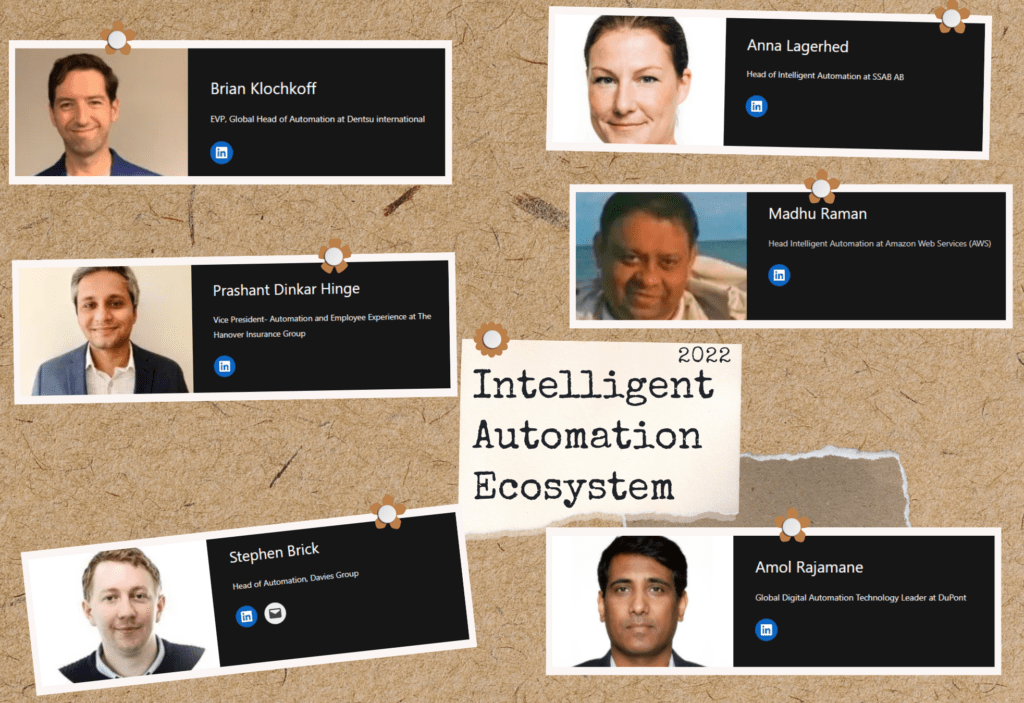We asked Intelligent Automation leaders what would be the most effective way you can build an effective automation ecosystem.
Based on the responses, here are a few common themes that our leaders see:
- Use Process mining/Task mining for more objective process discovery
- Design for Human enabled automation with people ideally at the center
- Incorporate more Artificial Intelligence solutions (ML, NLP, IDP etc.)
- Add Humans in the loop to increase automation success
- Aim for more Straight through processing with technologies like AI-ML
And without more ado, here is what each of the experts said. Note that these represent their personal opinions and not that of their employer.
This is a continuation of our Intelligent Automation expert series. Here is the first one with the Automation trends.

Brian Klochkoff
EVP, Global Head of Automation at Dentsu international
- Community: People enablement is at the forefront of successful enterprise-scale automation programs. Building a strong automation community across the organization not only drives awareness and use case pipeline but also enables a strong citizen development program with peer-to-peer support.
- Process Mining & Insights: A pipeline full of employee-submitted ideas is great, but being able to validate those ideas with empirical data and current state documentation accelerates how citizen developers, solution architects, and professional developers convert ideas into solutions. The insights part of process mining is also key as organizations need to pause and assess if a use case is really best suited for automation or perhaps there is a BPO, change management, or training opportunity involved.
- Automation as a Service Platform: As more COEs move out of the POC phase and are challenged with tackling a pipeline, on-prem technical debt and infrastructure maintenance get in the way of designing, developing, and deploying impactful solutions. Cloud-hosted automation platforms like UiPath Automation Cloud enable the enterprise to integrate with complementary third-party products/services while not having to worry about infrastructure patching and versioning.
- Internal Solution Marketplace: As programs scale, redundant use cases and solutions find their way into the idea pipeline. Putting a solution marketplace into the organization enables the automation community members to consume and build on top of existing vetted solutions while also stitching together reusable componentry. This is a win for automation consumers, developers, and stakeholders alike.
- Public-Facing Success Metrics: Accountability is key as hype fades away and solution delivery is expected. By exposing and visualizing non-sensitive data about your automation program to the enterprise’s employee base, not only do you force accountability for the delivery teams but you also harness the data exhaust created by your community, process mining, and solutions programs to facilitate better decision-making across the business and start the path towards AI-driven predictive intelligence by structuring previously unstructured process and solution data at enterprise scale.

Madhu Raman
Head Intelligent Automation at Amazon Web Services (AWS)
- Businesses will increasingly look to the cloud as the deployment home for enterprise-wide intelligent automation due to the broad & deep services tool chest, better resilience, and scaling.
- Enterprise Integration PaaS (EiPaaS) tools may see increased adoption by line of business leaders for process improvement solution implementations within business units.
- Businesses will be able to use process mining and task mining outputs to auto-assemble intelligent automation workflows. The ability to deploy digital workers that embed business KPI monitoring within an output workflow will start becoming table stakes functionality.
- Customer adoption of intelligent automation will be driven by proof of value trials that accelerate time to value for enterprise operations and industry specific solutions. These will be science-of-the-doable engagements using proven components with high straight through processing out of the box.
- Low code No code pure play platforms will likely help customers cross over to focusing on what has to date been RPA-vendor play with intelligent automation for enterprise operations and industry-specific assembly of their solutions portfolio.

Anna Lagerhed
Head of Intelligent Automation at SSAB AB
- Is there a one-size fits all solution for Hyper/Intelligent automation? Maybe there is, but that means you might buy a Tesla when you need a Volvo. Start small, think big.
- Go use case by use case. A combination of new technologies can allow you to solve use cases that were dismissed one or two years ago.
- The service providers landscape is seemingly infinite and it’s very hard to establish what’s what. You might end up in “analysis paralysis” just trying to understand what’s out there. Use any service provider you trust for the first year. After that, you will have learned what you need and can proceed with a proper RFP if required.
- Large service providers are adding more and more capabilities. If you have already invested in them, give it a try. But niche players tend to be way ahead of the larger ones.
- Intelligent Document Processing and Machine Learning are two key elements to move from RPA to Hyper/Intelligent automation. Without the ability to use structured unstructured and semi-structured data, RPA can only take you so far. Combined, you can achieve end-to-end process automation and allow you to stop using people as band-aids for fractured processes and systems.

Prashant Dinkar Hinge
Vice President- Automation and Employee Experience at The Hanover Insurance Group
- Business, IT, and Automation strategies converge and align roadmaps. Leading to integrated planning and providing visibility into value creation/capture.
- Artificial Intelligence solutions (ML, DL, Computer Vision, NLP, etc.) supersede standalone technology use cases e.g. RPA, RDA, BPM, etc.
- End to End Automation orchestration becomes central to Automation CoE charter and will leverage tools such as Process mining, Low-Code apps, AI, Chatbots, etc. Citizen development will be focused on small/task based automations.
- Automation teams align and organize delivery/support around concepts such as “straight-through processing” and align on a project basis with IT organizations to deliver human-enabled automation solutions, propagating hybrid work environments.
- RPA moves from “leading to last-mile automation tool” as marketing and sales budgets dwindle- If your automation portfolio is unbalanced and continue to invest in it- this is the definition of insanity!

Stephen Brick
Head of Automation, Davies Group
- Organisations have traditionally treated RPA and Intelligent Automation as another solution that will be the silver bullet, able to solve all of a process’s inherent inefficiencies, while deployed in isolation and siloed from other processes or technology. Deploying automation in this way will only allow you to get the bare minimum out of the technology, limiting its use and successes, inevitably preventing an organisation from scaling their digital workforce.
- RPA and Intelligent Automation should be the starting point to looking at your organisation holistically, not taped off with the usual restrictions and barriers assigned to each process or department, and not just on a process-by-process basis. The whole organisation can be re-imagined and re-designed by putting humans at the centre, whether this is employees or the customer. This will shape a human intelligence strategy which then informs where this powerful technology can be used to support humans, achieving improved end to end customer experiences and supporting optimisation across the organisation.
- As we look forward to 2022 and beyond, organisations will move to a more central connected intelligence model enabling full digital transformation and innovation.
- Organisations will start to leverage automation technologies to ‘plug’ into key data and decision points of legacy systems and applications. Rather than automation actually doing the process, it will be used to identify and structure key data points, then feed this into a more centralised data lake / warehouse, allowing organisations full visibility and insights on data that was previously inaccessible by system reporting.
- Human in the Loop is key for any ‘End to End’ process. If planned and executed well, it can alleviate most, if not all, of the manual work that is completed by the business in just gathering and extracting the data, allowing humans to decide on the outcomes. If this is layered with AI and machine learning, it can be automated further over time with minimal impact on BAU and the customer journey/experience.

Amol Rajamane
Global Digital Automation Technology Leader at DuPont
- Process and Task Mining will help analyze existing business processes in real-time, help identify the bottlenecks and remove inefficiencies by doing more automation. Process mining has become the foundation to hyperautomation (or Intelligent Automation).
- Human-Digital worker Collaboration has become critical for business success, Low-Code/No-Code platforms/collaboration tools will play a very crucial role to improve interactions between human and digital workers. Human in the Loop will reduce exceptions and increase the success rate of automation.
- Dashboarding/Reporting tools like PowerBI have become integral part of automations. RPA and AI/ML is helping gather and process data much faster (or real-time) and more accurately to bring more meaningful insights to businesses.
- Integration and API Platforms will improve the maintainability of interfaces/automation, reduce dependency on UI-based automation and process data much faster.
- AutoML/AIML/NLP is already being used for data preparation, forecasting, predictive analysis, decision making to improve straight-through processing of business processes.
Thanks to Alex Dixon for reviewing and helping with this expert series article.
